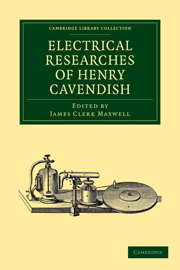INTRODUCTION BY THE EDITOR
Published online by Cambridge University Press: 05 July 2011
Summary
So little is known of the details of the life of Henry Cavendish, and so fully have the few known facts been given in the Life of Cavendish by Dr George Wilson, that it is unnecessary here to repeat them except in so far as they bear on the history of his electrical researches.
He was born at Nice on the 10th October, 1731, he became a Fellow of the Royal Society in 1760, and was an active member of that body during the rest of his life. He died at Clapham on the 24th February, 1810.
His father was Lord Charles Cavendish, third son of William, second Duke of Devonshire, who married Lady Anne Grey, fourth daughter of the Duke of Kent. Henry was their eldest son. He had one brother, Frederick, who died 23rd February, 1812.
Of Lord Charles Cavendish we have the following notice by Dr Franklin. After describing an experiment of his on the passage of electricity through glass when heated to 400° F., he says,
“It were to be wished that this noble philosopher would communicate more of his experiments to the world, as he makes many, and with great accuracy.”
Lord Charles Cavendish has also recorded a very accurate series of observations on the depression of mercury in glass tubes, and these have furnished the basis not only for the correction of the leading of barometers, &c., but for the verification of the theory of capillary action by Young, Laplace, Poisson and Ivory.
- Type
- Chapter
- Information
- Electrical Researches of Henry Cavendish , pp. xxvii - lxviPublisher: Cambridge University PressPrint publication year: 2010First published in: 1879



